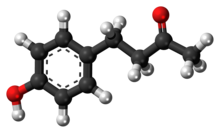 | |
 | |
| Names | |
|---|---|
| Preferred IUPAC name 4-(4-Hydroxyphenyl)butan-2-one | |
| Other names p-Hydroxybenzyl acetone; 4-(p-Hydroxyphenyl)-2-butanone; Frambinone; Oxyphenylon; Rheosmin; Rasketone | |
| Identifiers | |
| CAS Number | |
| 3D model (JSmol) | |
| Abbreviations | RK |
| ChEBI | |
| ChEMBL | |
| ChemSpider | |
| ECHA InfoCard | 100.024.370 |
| EC Number |
|
| PubChem CID | |
| UNII | |
| CompTox Dashboard (EPA) | |
InChI
| |
SMILES
| |
| Properties | |
| Chemical formula | C10H12O2 |
| Molar mass | 164.204 g·mol |
| Appearance | White needles |
| Melting point | 82 to 84 °C (180 to 183 °F; 355 to 357 K) |
| Boiling point | 140 to 146 °C (284 to 295 °F; 413 to 419 K) at 0.5 mmHg |
| Hazards | |
| GHS labelling: | |
| Pictograms | 
|
| Signal word | Warning |
| Hazard statements | H302 |
| Precautionary statements | P264, P270, P301+P312, P330, P501 |
| Except where otherwise noted, data are given for materials in their standard state (at 25 °C , 100 kPa).
| |
Raspberry ketone is a naturally occurring phenolic compound that is the primary aroma compound of red raspberries.
Occurrence
Raspberry ketone occurs in a variety of fruits, including raspberries, cranberries, and blackberries. It is detected and released by orchid flowers, e.g. Dendrobium superbum (syn D. anosmum), and several Bulbophyllum species to attract raspberry ketone-responsive male Dacini fruit flies. It is biosynthesized from coumaroyl-CoA. It can be extracted from the fruit, yielding about 1–4 mg per kg of raspberries.
Preparation
Since the natural abundance of raspberry ketone is very low, it is prepared industrially by a variety of methods from chemical intermediates. One of the ways this can be done is through a Claisen-Schmidt condensation followed by catalytic hydrogenation. First, acetone is condensed with 4-hydroxybenzaldehyde to form an α,β-unsaturated ketone. Then the alkene part is reduced to the alkane. This two-step method produces raspberry ketone in 99% yield. There is a less expensive hydrogenation catalyst, nickel boride, which also demonstrates high selectivity towards hydrogenation of the double bond of enone.
Uses
Raspberry ketone is sometimes used in perfumery, in cosmetics, and as a food additive to impart a fruity odor. It is one of the most expensive natural flavor components used in the food industry. The natural compound can cost as much as $20,000 per kg.
Marketing
Although products containing this compound are marketed for weight loss, there is no clinical evidence for this effect in humans. They are called "ketones" because of the ketone (acetone) group at their end, which is shared with ketone bodies.
Safety
Little is known about the long-term safety of raspberry ketone supplements, especially since little research has been done with humans. Toxicological models indicate a potential for cardiotoxic effects, as well as effects on reproduction and development. Furthermore, in many dietary supplements containing raspberry ketones, manufacturers add other ingredients such as caffeine which may have unsafe effects.
In 1965, the US Food and Drug Administration classified raspberry ketone as generally recognized as safe (GRAS) for the small quantities used to flavor foods.
See also
References
- Catalog of Organics and Fine Chemicals, Acros Organics, 2004/05, page 1250.
- ^ "4-(p-Hydroxyphenyl)-2-butanone". Food and Cosmetics Toxicology. 16: 781–2. 1978. doi:10.1016/S0015-6264(78)80113-8.
- "Raspberry Ketone, Molecule of the Month". University of Bristol.
- Nishida, R.; Iwahashi, I.; Tan, K.H. (1993). "Accumulation of Dendrobium (Orchidaceae) flower fragrance in the rectal glands by males of the melon fly, Dacus cucurbitae (Tephritidae)". Journal of Chemical Ecology. 19: 713–722. doi:10.1007/BF00985003.
- Tan, K.H.; Nishida, R. (2005). "Synomone or Kairomone? - Bulbophyllum apertum (Orchidaceae) flower releases raspberry ketone to attract Bactrocera fruit flies". Journal of Chemical Ecology. 31 (3): 509–519. doi:10.1007/s10886-005-2023-8.
- Tan, K.H.; Tan, L.T. (2018). "Movements of floral parts and roles of the tooth on column wall of Bulbophyllum praetervisum (Orchidaceae) flower for pollination by Dacini fruit flies (Diptera: Tephritidae)". Journal of Pollination Ecology. 24 (17): 157–163. doi:10.26786/1920-7603(2018)19.
- Nakahira, M.; Ono, H.; Wee, S.L.; Nishida, R. (2018). "Floral synomone diversification of Bulbophyllum sibling species (Orchidaceae) in attracting fruit fly pollinators". Biochemical Systematics and Ecology. 81: 86–95. doi:10.1016/j.bse.2018.10.002. hdl:2433/235528.
- "MetaCyc Pathway: raspberry ketone biosynthesis". MetaCyc. Retrieved 2012-07-12.
- ^ Beekwilder, Jules; Van Der Meer, Ingrid M.; Sibbesen, Ole; Broekgaarden, Mans; Qvist, Ingmar; Mikkelsen, Joern D.; Hall, Robert D. (2007). "Microbial production of natural raspberry ketone". Biotechnology Journal. 2 (10): 1270–9. doi:10.1002/biot.200700076. PMID 17722151. S2CID 32088996.
- Tateiwa, Jun-Ichi; Horiuchi, Hiroki; Hashimoto, Keiji; Yamauchi, Takayoshi; Uemura, Sakae (1994). "Cation-Exchanged Montmorillonite-Catalyzed Facile Friedel-Crafts Alkylation of Hydroxy and Methoxy Aromatics with 4-Hydroxybutan-2-one to Produce Raspberry Ketone and Some Pharmaceutically Active Compounds". The Journal of Organic Chemistry. 59 (20): 5901–4. doi:10.1021/jo00099a017.
- Smith, Leverett R. (1996). "Rheosmin ('Raspberry Ketone') and Zingerone, and Their Preparation by Crossed Aldol-Catalytic Hydrogenation Sequences". The Chemical Educator. 1 (3): 1–18. doi:10.1007/s00897960034a. S2CID 94729547.
- Bandarenko, Mikhail; Kovalenko, Vitaly (2014). "Synthesis of Raspberry and Ginger Ketones by Nickel Boride-catalyzed Hydrogenation of 4-Arylbut-3-en-2-ones". Zeitschrift für Naturforschung B. 69b (8): 885–888. doi:10.5560/ZNB.2014-4118.
- "Raspberry Ketones: Uses, Health Benefits, and Risks". WebMD.
- "Raspberry Ketone". WebMD.
- ^ Bredsdorff L, Wedebye EB, Nikolov NG, Hallas-Møller T, Pilegaard K (2015). "Raspberry ketone in food supplements - High intake, few toxicity data - A cause for safety concern?". Regul Toxicol Pharmacol. 73 (1): 196–200. doi:10.1016/j.yrtph.2015.06.022. PMID 26160596. S2CID 38312188.
- Cathy Wong. "Raspberry Ketones for Weight Loss". About.com.
- ^ Canberra, Jules. "What's All The Hype About Raspberry Ketone?". Authority Health. Retrieved 30 October 2017.
